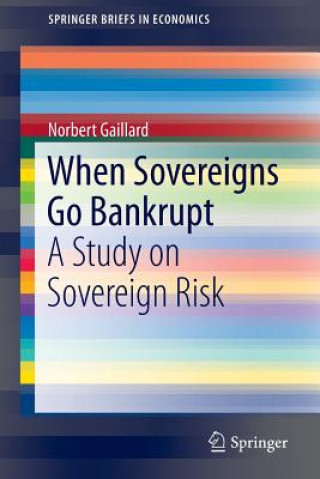
Kód: 02779857
When Sovereigns Go Bankrupt
Autor Norbert Gaillard
The public debt crisis that Eurozone countries have experienced since 2010 has been accompanied by a resurgence of sovereign risk. Greece was obliged to restructure its debt in 2012. The credit position of even the wealthy countri ... celý popis
- Jazyk:
 Angličtina
Angličtina - Vazba: Brožovaná
- Počet stran: 70
Nakladatelství: Springer International Publishing AG, 2014
- Více informací o knize

1681 Kč

Skladem u dodavatele v malém množství
Odesíláme za 12-17 dnů
Potřebujete více kusů?Máte-li zájem o více kusů, prověřte, prosím, nejprve dostupnost titulu na naši zákaznické podpoře.
Přidat mezi přání
Mohlo by se vám také líbit
-

Lucile
673 Kč -

Spooks Vol.4: the 46th State
402 Kč -

Finding God in the Psalms
391 Kč -

Polymer Modification
5094 Kč -

Witches' Love Spell Book
177 Kč -

Petunia Paris's Parrot
222 Kč -

Maths is Awesome!
252 Kč
Dárkový poukaz: Radost zaručena
- Darujte poukaz v libovolné hodnotě a my se postaráme o zbytek.
- Poukaz se vztahuje na celou naši nabídku.
- Elektronický poukaz vytisknete z e-mailu a můžete ihned darovat.
- Platnost poukazu je 12 měsíců od data vystavení.
Více informací o knize When Sovereigns Go Bankrupt
Nákupem získáte 168 bodů
 Anotace knihy
Anotace knihy
The public debt crisis that Eurozone countries have experienced since 2010 has been accompanied by a resurgence of sovereign risk. Greece was obliged to restructure its debt in 2012. The credit position of even the wealthy countries is shakier than at any time since the Great Depression. Now more than ever it is essential to understand sovereign risk because the default of a country, or even its lack of credibility, is bound to jeopardize political stability and weaken the credit standing of all other economic actors. This book reviews and analyzes the different means used to forestall and protect against sovereign defaults. In light of the Eurozone s 2010-2012 sovereign debt crisis, this book also emphasizes the roots of sovereign creditworthiness. Chapter 1 establishes a typology of sovereign defaults. A sovereign bankruptcy may take many forms (debt repudiation, moratorium, restructuring, etc.). Chapter 2 presents the different contractual and legal tools used to protect against sovereign defaults. Chapter 3 investigates how some investors have been able to interfere with the debtor s economic policy by insisting that measures be taken to reduce the risk of default in the short and medium term. Such interference can be direct or may be more subtle. There is a specific focus on the conditionality imposed by the International Monetary Fund. Chapter 4 studies the various tools that investors can use to discriminate among borrowers and forecast debt crises (bond yields and spreads as well as ratings provided by Fitch, Moody s, Standard & Poor s, and Euromoney Country Risk). Chapter 4 also demonstrates that sovereign debtors must overcome seven types of risk in order to preserve their creditworthiness: natural disaster, geopolitical risk, institutional and political risk, economic risk, monetary and exchange rate risk, fiscal and tax-system risk, and debt-related risk.§
 Parametry knihy
Parametry knihy
1681 Kč
- Plný název: When Sovereigns Go Bankrupt
- Podnázev: A Study on Sovereign Risk
- Autor: Norbert Gaillard
- Jazyk:
 Angličtina
Angličtina - Vazba: Brožovaná
- Počet stran: 70
- EAN: 9783319089874
- ISBN: 3319089870
- ID: 02779857
- Nakladatelství: Springer International Publishing AG
- Hmotnost: 1416 g
- Rozměry: 235 × 155 × 6 mm
- Datum vydání: 15. August 2014
Oblíbené z jiného soudku
-

Dune
262 Kč -

Haunting Adeline
617 Kč -

Berserk Deluxe Volume 2
1050 Kč -

White Nights
90 Kč -

Powerless
259 Kč -

Atomic Habits
340 Kč -

Dune Messiah
178 Kč -

Berserk Deluxe Volume 3
1138 Kč -

One Day
276 Kč -

Berserk Deluxe Volume 1
1033 Kč -

Iron Flame
353 Kč -

Surrounded by Idiots
256 Kč -

Harry Potter and the Prisoner of Azkaban (Minalima Edition)
688 Kč -

Gravity Falls Journal 3
440 Kč -

Heaven Official's Blessing: Tian Guan Ci Fu (Novel) Vol. 1
426 Kč -

The Creative Act
544 Kč -

Dune
214 Kč -

Hunting Adeline
633 Kč -

A Little Life
276 Kč -

Children of Dune
174 Kč -

Heaven Official's Blessing: Tian Guan Ci Fu (Novel) Vol. 2
441 Kč -

Bungo Stray Dogs, Vol. 8 (light novel)
426 Kč -

Percy Jackson and the Olympians 5 Book Paperback Boxed Set
953 Kč -

Solo Leveling, Vol. 1
461 Kč -

The Prisoner's Throne
238 Kč -

Court of Thorns and Roses
254 Kč -

Cry Baby Coloring Book
256 Kč -

Fourth Wing
351 Kč -

Icebreaker
200 Kč -

Berserk Deluxe Volume 6
1086 Kč -

Avatar, the Last Airbender: The Kyoshi Novels (Box Set)
676 Kč -

The 48 Laws of Power
530 Kč -

House of Leaves
405 Kč -

Twisted Lies
276 Kč -

Dune Messiah
220 Kč -

No Longer Human
340 Kč -

48 Laws Of Power
471 Kč -

Twisted Games
214 Kč -

Caraval Paperback Boxed Set
906 Kč -

Solo Leveling, Vol. 2
448 Kč -

Open Circuits
861 Kč -

Berserk Deluxe Volume 5
1115 Kč -

Heaven Official's Blessing: Tian Guan Ci Fu (Novel) Vol. 3
410 Kč -

Berserk Deluxe Volume 4
1165 Kč -

Court of Mist and Fury
221 Kč -

SOLO LEVELING V08
450 Kč -

English File Upper Intermediate Multipack A (4th)
495 Kč -

CHAINSAW MAN V14
250 Kč -

Before the Coffee Gets Cold
191 Kč
Osobní odběr Praha, Brno a 12903 dalších
Copyright ©2008-24 nejlevnejsi-knihy.cz Všechna práva vyhrazenaSoukromíCookies


 Vrácení do měsíce
Vrácení do měsíce 571 999 099 (8-15.30h)
571 999 099 (8-15.30h)